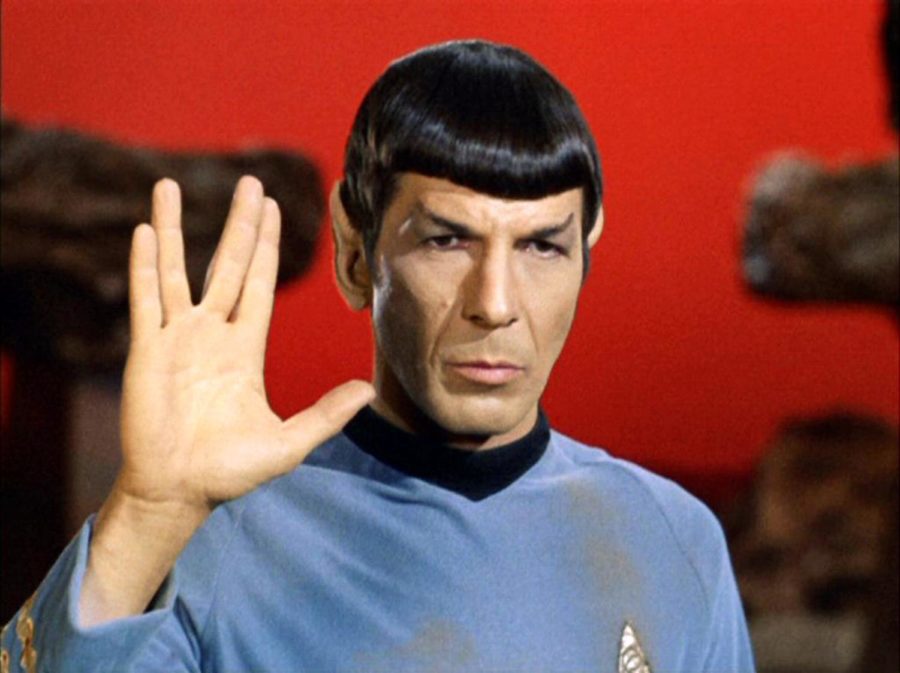The Vulcan Salute in Halacha
March 8, 2023
Special thanks to Rabbi Milevsky for providing us with the Halakhic sources and guiding us through this process.
Leonard Nimoy’s Story:
Nimoy was sitting in shul with his grandfather and the Kohanim went up to bless the congregation, where he noticed the hands of the kohanim as they duchanned. Years later when he was shooting Star Trek he recommended that the Vulcans, a highly intelligent species whom Nimoy’s character, Spock, was one of, have their own greeting. In the final draft of the show, the two- handed Birkat Kohanim “salute” became the Vulcan Salute.
Nimoy was the son of Ukrainian Jewish immigrants that raised him in the orthodox tradition. Nimoy and his family attended Boston’s Orthodox North Russell Street synagogue. Records of this synagogue and the minhagim they followed cannot be found on the internet. As his parents were Ukrainian, Leonard probably attended an Ashkenazi synagogue which therefore followed Ashkenazi minhagim. Although not certain, It is plausible to assume that the Kohanim’s hands may have been outside of the tallit for Leonard to see as this was an Ashkenazi practice in Europe.
Hilchot Birkat Kohanim:
Rabbi Yehuda includes looking at the Kohanim’s hands during Birkat Kohanim as one of the three things that will make a man’s eyes go dim. (Megillah 16). Rashi notes that when the Kohanim blessed Bnei Yisrael, the Shechina would rest on their fingers. The Gemara in Megillah 24b talks about the Halachot of a man with blemishes on any part of his body. This man is prohibited from performing Birkat Kohanim because it may cause the congregation to look at him. According to Rashi, this would subsequently make his eyes go dim. But Tosfot points out that we are no longer in the times of the Beit Hamikdash and therefore, we would not have to worry about our eyes going dim. Nonetheless, the Rivavan resolves this issue in Masechet Megillah, by stating that the law of not looking would persist because it is a Gizeira for the Beit Hamikdash.
The Beit Yosef records an Egyptian custom for the Kohanim to place their hands underneath the Tallit so as to prevent the congregation from seeing them. The Beit Yosef indicates that this is a good thing to do, but other authorities disagree. Rav Moshe Isserlis, in his book the Darchei Moshe, records the Polish Ashkenazi custom to leave the hands outside the Tallit so that the Kohanim themselves are not distracted. The Levush, another Ashnkenazi authority, says that the hands should be outside the Tallit. From these sources we see a clash between keeping the Kohen focused and keeping the congregation focused.
In his work the Aruch HaShulchan, Rav Yechiel Michel Epstien presents a solution. He writes that the minhag in his area, Lithuania, was for the Kohanim to place their hands underneath the Tallit, but have a portion of the Tallit ‘darken’ the hands so that the Kohanim themselves could not see them. In America, the common practice is to keep the hands within the Tallit. However, this is not necessarily the case in Chassidic shuls. Rav Shneur Zalman of Liadi, the first Chabad Rebbe, says that the hands of the Kohanim should be outside the Tallit because while the Kohanim are blessing the congregation, there should be no barrier between their hands and the congregation. This is a Kabbalistic approach, which is followed in the Chabad community.
So What about Leonard Nimoy?:
Interestingly, parts of Nimoy’s description do not align with common Jewish practice. For example, Nimoy jokes that he “managed to” survive looking at the Kohanim’s hands, even though looking at the hands would cause “death” (due to the presence of the Shechina). However, most authorities dispute the idea that the Shechina is present between the Kohanim’s fingers nowadays. Another troubling detail is how Nimoy saw the Kohanim’s fingers outside the tallitim, since most opinions hold that the Kohanim should place their fingers inside of their tallitim.
One explanation is that Nimoy already knew all about Birkat Kohanim, and was just overdramatizing the event. Nimoy also takes a dramatic approach when explaining the Shechina’s power, but stays mostly faithful to halachic interpretations. Alternatively, Nimoy may have attended a synagogue that followed the tradition to place the hands outside of tallitim; and Nimoy’s rabbinical acquaintance may have accepted the view that the Shechina is still present between the Kohanim’s fingers, as explained above.
To give credit to Nimoy, most of his explanation accords with halachic interpretation. He accurately describes where the Kohanim would have stood in the synagogue, their words, and their chanting. Nimoy also expounds on a common name for this practice (“duchaning”), the connection between the hands and the letter “ש”, and some symbolism behind the letter “ש”.


